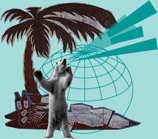Act 1: Iceland, March 24 – April 16, 2006
ART EXHIBITION
Past Colonies – Present Empires:
How “Post” is Postcolonialism?
The Living Art Museum, Reykjavik
March 24 – April 16, 2006
Opening Friday, March 24, 2006, 5 – 8 pm
Press Preview Friday, March 24, 2006, 2 – 4 pm
This first exhibition in the series revisits the past and investigates the dynamics of colonialism on both sides of the colonized/colonizer divide. It looks at the degree to which such dynamics are still at play today. Doing this, the exhibition points to a complex field of conflicting interests and questions the possibility of postcolonial “truths.”
The exhibition is accompanied by the film program Silver Screen Resistance (for screening hours and participant information, click here).
PARTICIPATING ARTISTS
Julie Edel Hardenberg (Greenland)
Inuk Silis Høegh & Asmund Havsteen-Mikkelsen (Greenland/Denmark & Denmark)
Maryam Jafri (Pakistan/USA/Denmark)
Steve Ouditt (Trinidad, The West Indies)
Ósk Vilhjálmsdóttir (Iceland)
Kara Walker (USA)
FILM PROGRAM PARTICIPANTS
Stephanie Black (USA)
Randi Broberg in collaboration with Tine Bryld (Greenland/Denmark & Denmark)
Laila Hansen (Greenland)
Isaac Julien (United Kingdom)
Alanis Obomsawin (Abenaki, Canada)
Pratibha Parmar (Kenya/United Kingdom)
Gillo Pontecorvo (Italy)
Paul-Anders Simma (Sámi, Norway/Sweden/Finland)
Address/Hours/Admission:
Laugavegi 26, 4th floor, 101 Reykjavik
t: +354 551 4350, e: nylo@nylo.is, www.nylo.is
Wednesday – Sunday, 1 – 5 pm
Admission free
JULE EDEL HARDENBERG
Born 1971 in Nuuk, Greenland. Lives and works in Nuuk.
Julie Edel Hardenberg holds a MA in Art Theory and Communication. Julie has throughout her education lived in most of Scandinavia and has attended The Nordic School of Art in Kokkola, Finland; The Art Academy in Trondheim, Norway; and The Royal Danish Academy of Fine Arts in Copenhagen, Denmark. This has given her a solid basic foundation to put into perspective and at the same time distance herself from her work topic: cultural diversity, differences, and coherences as counter-poles to the political currents of nationalism and the prevalent definition of types from the mass media. She is a product of two cultures herself, having a Danish father and a Greenlandic mother. Julie released the children’s pixie- and pointing book Haluu, Hej, Hello in 2003 and was earlier this year nominated for the Nordic Prize of Literature with her second book release The Quiet Diversity from 2005. She has also been recognized as one of the fifty most promising young photographers in the world by Musée de l’Elysée, Lausanne, Switzerland. In addition to her curriculum vitae, which counts international exhibitions, recognitions, and public tasks, Julie has alongside her artistic practice worked with scenography and installations for both feature films, theater plays, and dancing shows. [Julie Edel Hardenberg]
Julie Edel Hardenberg participates with works from The Quiet Diversity. In the foreword to the book, Iben Salto writes: “The question of culture and identity has always been a preoccupation for Julie. In her artistic work she has on several occasions created works which in some way are related to cultural ‘splits’. She has, as many other ‘half-breeds’, felt pressure to choose between a Greenlandic and a Danish identity. It was a relief for her to go abroad. The time she studied in Finland became the decisive factor for her development; there she found a neutral place where she could abandon all concern with identity problems and instead make room for herself and her own development. Julie takes a stand both personally and in her artistic work with regard to the stereotyping of cultural images, especially those that are related to Greenland. The Greenlandic artists have, with respect to the political aspects of culture, been entrusted with the task of functioning as links between the ‘old’ Greenland and the ‘new’. They are assumed to have access to the culture as a resource and to work under some sort of obligation to describe and guard it. There is even talk of a special Greenlandic art, which is defined in terms of something ethnic. This is all supported by the cultivation of cultural originality in indigenous art by art experts, museum curators and politicians. Many Greenlandic artists themselves maintain that their main inspiration, for instance, is the magnificent landscape or the mythology, and state in a very direct way that they draw on their cultural roots in their art. Julie does not live up to that expectation. She has instead enlisted herself in a post-colonial debate, and makes the question of ethnic identity a preoccupation and a subject for artistic exploration. In some of her highly conceptual photographic works she portrays herself, her friends and acquaintances with different effects which one customarily associates with something ethnic. But instead of delivering the ethnic goods, questions are also raised here in these works as to what ethnic really consists of.” [Iben Salto, “The Quiet Diversity,” in Julie Edel Hardenberg, The Quiet Diversity, Nuuk: Milik Publishing, 2005]
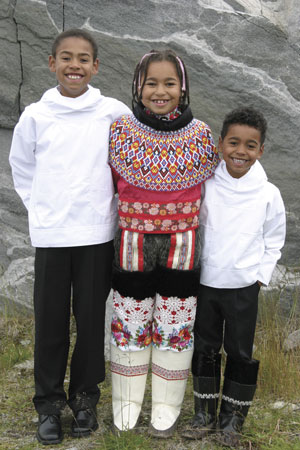
Julie Edel Hardenberg, “Nonstereotypes,” 2004.
Photograph, A2. Courtesy of the artist.
INUK SILIS HØEGH
Born 1972 in Qaqortoq, Greenland. Currently lives and works in Copenhagen, Denmark.
Inuk Silis Høegh has worked mainly as a film director and cinematographer, but began in 2000 to experiment with video, sculpture, and installation also. He holds a MFA in Filmand TV Production from the University of Bristol, United Kingdom (1997) and is a member of Kimik – The Artists Association in Greenland and Assilissat – The Filmmakers’ Association in Greenland. [Tone Olaf Nielsen]
Inuk Silis Høegh participates with a new version of the project “Meelting Barricades.” The project was originally produced by Inuk Silis Høegh in collaboration with Danish artist Asmund Havsteen-Mikkelsen for the 25th Anniversary of the Greenlandic Home Rule Government on June 21, 2004. Høegh states about the project: “We wanted to make a Greenlandic army – an absurdity given the country’s size and population. Taking our point of departure in the rhetorics of the military, we posed the question: What values does Greenland wish to preserve and contribute with in a globalized world? Once Greenland becomes independent, the country should not uncritically become a part of globalization’s tendency to homogeneity, nor should it withdraw in national self-sufficiency. Cultural barricades will melt, and new ones will arise. The question is how this transition should take place – and how Greenland will find its own two feet to stand on. Our project was many-sided and began with a performance in downtown Nuuk, May 2004. Dressed as two Greenlandic generals, we marched with drums and soldiers down the main street and encouraged everyone to join Greenland’s Defense Forces. The next part of the project consisted of founding the Greenlandic Command Post at the Usk Ukalisuaq School in June. As part of the discussion of Greenlandic values, we had arranged a drawing competition for all Greenlandic children entitled ‘What do you like about your country?’ These drawings, as well as propaganda films, invasions plans, and possible attack scenarios, became part of the final exhibition. In August 2004, we launched the second part of the project: a Greenlandic invasion of Denmark. The position of the colonial power was turned upside down in that Greenland was presented as the superior cultural and military power. The invasion was initiated in the culture house, Nordatlantens Brygge, in Copenhagen. During the opening, we staged a victory parade in an armored vehicle in the streets of Copenhagen. Inside the exhibition, which was built as a military camp, we held a speech announcing the proportions of the occupation and the future plans for Greenland’s Defense Forces. Furthermore, audiences were presented with the strategy used to occupy the Danish Parliament, a specially designed torture chamber, an overview of military resources, and the army’s plans for increasing the Greenlandic population.
For Rethinking Nordic Colonialism, the propaganda from ‘Melting Barricades’ is recreated in a new installation. Greenland’s Defense Forces are about to conquer the world and more recruits are needed. Using video, photo, text, graphics, and installation, ‘Melting Barricades’ discusses Greenland’s wish for independence and the position of the former colony in the international community. The title of the project points to some of the political consequences that the defense of one’s territory and culture cause – on both an international and human level. Barricades are not only territorial, national, and economic, but also psychological and cultural. An absolute independence indicates – in the case of Greenland – a displacement of these barricades and thereby new conditions for understanding oneself and the surrounding of the world.” [Inuk Silis Høegh]
Thanks to U.S. Overskudslager, Dansk Veteranbiludlejning, Den Danske Trådvarefabrik, and Beredskabsstyrelsen.
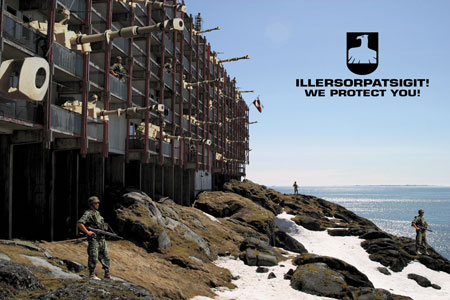
Inuk Silis Høegh & Asmund Havsteen-Mikkelsen, “We Protect You,” 2004.
Digital print, 100 x 80 cm. Courtesy of the artists.
MARYAM JAFRI
Born 1972 in Karachi, Pakistan. Lives and works in Copenhagen, Denmark and New York, USA.
Maryam Jafri is an artist whose work focuses on the role of narrative and history in constructing identities, from the individual to the national. She is a 2000 graduate of the Whitney Museum Independent Study Program, New York. Recent solo exhibitions include Malmö Konstmuseum, Sweden; Helsinki Konsthall, Finland; and Neuer Berliner Kunstverein, Berlin, Germany. Her work has been included in numerous group shows and video festivals in Europe, the US, and Asia.
“Siege of Khartoum, 1884” from 2005-2006 appropriates iconic images from the Iraq war invasion (such as the capture of Saddam, the tearing down of his statue in the public square) and combines them with archival news texts from earlier points in history. The texts come from archives of The New York Times, The Daily Telegraph, and The Times of London. The articles span from the period of high empire (late 19th century) to the present day. They include Winston Churchill’s journalist writings while battling Mahdists in Sudan (1898), British attempts to suppress the Mau Mau uprising in Kenya (1950s), two anonymous American journalists’ depictions of the conquest of the Philippines (1890s), Vietnam (1960s), and Panama (1990s). The juxtaposition of archival texts with contemporary images reveals parallels between past and present. The work reveals the way colonial wars of conquest have been packaged and presented in a palatable form to the home audience, and how the coverage of the contemporary Iraq war closely follows this predetermined script. [Maryam Jafri]
Special thanks to Lars Mathisen.
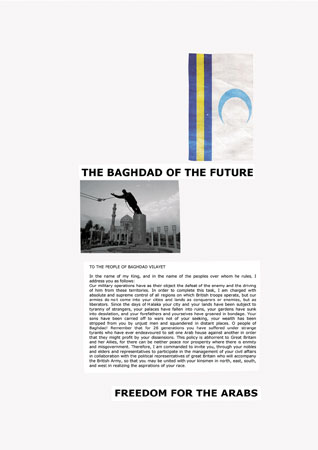
Maryam Jafri, “The Times (UK) 1917,” 2005-2006.
A1 poster, archival ink-jet on Hahnemuehle paper. Courtesy of the artist.
STEVE OUDITT
Born 1960 on Trinidad, The West Indies. Lives and works in St. Augustine, Trinidad.
Steve Ouditt is an artist and lecturer at the University of the West Indies, St. Augustine, Trinidad. He has worked as a Curator of Education and Research at the Institute of International Visual Arts [inIVA], London, and as a Lecturer at The Caribbean School of Architecture, Kingston, Jamaica. He has also been a researcher at the Jan van Eyck Academy, Maastricht, The Netherlands, and a visiting lecturer at the School of Architecture at Universidad Nacional Pedro Henrique Urena [UNPHU] in Santo Domingo, The Dominican Republic. His book creole in-site was published in London in 1998 by inIVA. Steve is presently researching how political communication engages design culture to create meanings of the nation, citizenship, law, culture, and human rights.
Steve Ouditt participates with a new installation entitled “TRADEMARK CAPITAL” consisting of a series of pictograms. He writes about the installation: “In almost all societies that were colonized, colonizers usurped already existing businesses and associations, and created many more. Indeed, capitalizing on the availability of conditions and diverse resources of people and places was a fundamental reason for colonization. Promotions and advertisements for products and services in the colonial era communicated cultural and social relations, apart from the obvious sales pitch. The aim of these pictograms are to create somewhat modern and future looking trademarks of a number of social, political, cultural, and economic factors that were fundamental to the colonial enterprise in order to maintain a lively discourse of colonization, in everyday exchanges in the contemporary Nordic societies. This installation is intended to relate to the paper ‘Plantation Economy and Trademark Capital’ for Act 1’s workshop that Ouditt also participates in.” [Steve Ouditt]
Thanks to silkscreen printer Keith Cadette and graphic artist Sabrina Charran.
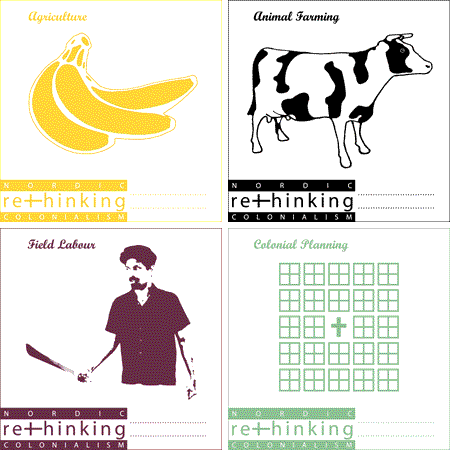
Steve Ouditt, “TRADEMARK CAPITAL,” 2006.
Silkscreen on card, 30 images, 18 cm sq. each. Silkscreen printer: Keith Cadette.
Graphic artist: Sabrina Charran. Courtesy of the artist
ÓSK VILHJÁLMSDÓTTIR
Born 1962 in Iceland. Lives and works in Reykjavik, Iceland.
Ósk Vilhjálmsdóttir is an artist, activist, and mountaineer. She studied at the Reykjavik Art Academy and Hochschule der Künste in Berlin (Meisterschüler, 1994). In her works, she has been dealing with the tension between the private and the public – and asking about the role art plays in society. She organizes and leads hiking tours in endangered areas of the Icelandic highlands. She was chairman of the board of the artist run gallery, The Living Art Museum, in Reykjavik from 2000-02, and has been giving lessons at the Academy of the Arts in Reykjavik and the Reykjavik School of Visual Art. Selected exhibitions count “Scheißland,” Island Bilder, Germany, 2005; Positive Growth – Negative Growth, ASI Art Museum, Reykjavik, 2005; “Settlement,” New Icelandic Art, National Gallery of Iceland, 2005; “Wohnglück/Traumhausmuster,” Bremen, Germany, 2005; “Polis,” Wroclaw, Poland, 2004; “Settlement”, Berlin North, Hamburger Bahnhof, Berlin, 2004; “Something Else”, Galleri Hlemmur, Reykjavik, 2003; In and Out of the Window (as The Art Nurses), ASI Art Museum, Reykjavik, 2003. Websites include: this.is/osk; this.is/artnurses; and this.is/augnablik/english.html.
Ósk Vilhjálmsdóttir contributes with a new project entitled “Power in your hands” from 2006. She writes about the project: “Mountaineering in the Icelandic highlands and environmental activism have for a long time been my sidelines. I have organized treks in a highland area where the Icelandic government has already started to build a huge hydroelectric power plant. This government task is the biggest project in the history of Iceland. Vast areas of untouched nature, the last remaining wildernesses of Europe, will be drowned September this year. It is a sacrifice the government decided to make for the American aluminum smelter company, Alcoa. The project has been carried forward by force, not enlightened discussion. Iceland is one of the smallest economies in the world. But the government is planning to make it one of the biggest aluminum producers in the world. The Icelandic government has defined the country as a heavy industry zone, a neo-colony for huge aluminum smelters. This will not only cause environmental but economical devastation as well.” [Ósk Vilhjálmsdóttir]
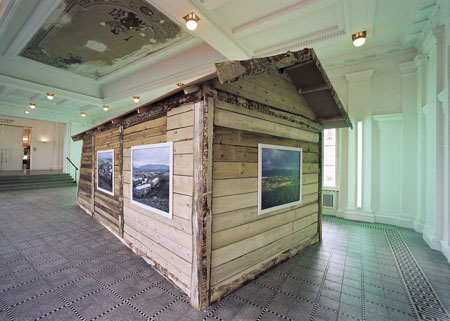
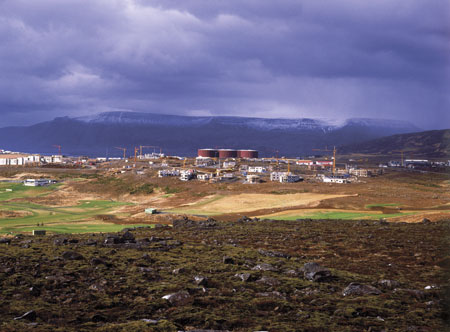
Ósk Vilhjálmsdóttir, “Settlement II,” 2004
Mixed media installation at Hamburger Bahnhof, Germany, dimensions variable
Photo: © Werner Zellin. Courtesy of the artist
KARA WALKER
Born 1969 in Stockton, California, USA. Lives and works in New York, USA.
Kara Walker is a visual artist. She holds a MFA in Painting/Printmaking from Rhode Island School of Design (1994) and a BFA in Painting/Printmaking from Atlanta College of Art (1991). She is known for exploring the intersection of race, gender, and sexuality through her silhouetted figures. Her work has been exhibited at the Metropolitan Museum of Art, The Museum of Modern Art, The San Francisco Museum of Modern Art, Museo de Arte Carrillo Gil, Ciudad de Mexico, The Solomon R. Guggenheim Museum, and The Whitney Museum of American Art. She was the United States representative at the 25th International Bienal of São Paolo in Brazil.
Kara Walker participates with two works: The film project “8 Possible Beginnings: or the Creation of Africa-America. A Moving Picture by the young, self-taught Genius of the South K.E. Walker” from 2005 and an untitled water color series from 2004. “8 Possible Beginnings…” is Walker’s second film project. It employs a series of montages using animated cut-paper marionettes to draw a picture of the nascent Antebellum South that is at times darkly menacing, and at others disturbingly comical. Likewise, Walker has added the element of sound – popular music from the turn of the century and her own narration – to the film. The work debuted in fall 2005 at REDCAT, Los Angeles. [Sikkema Jenkins & Co.]
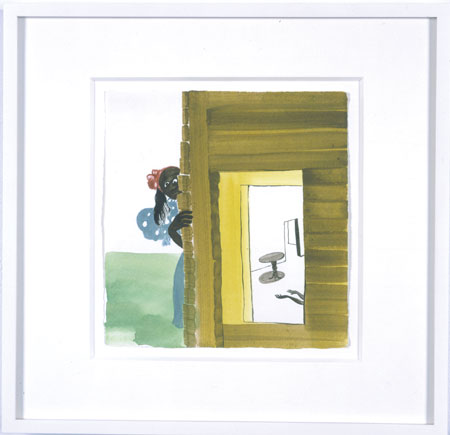
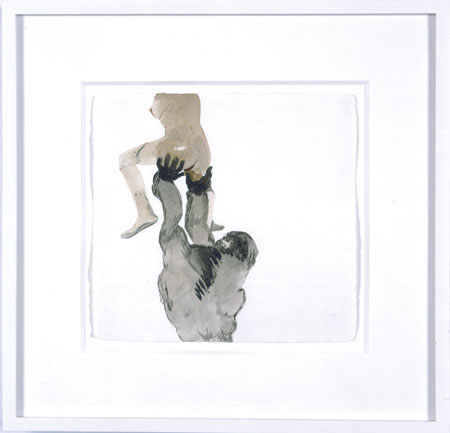
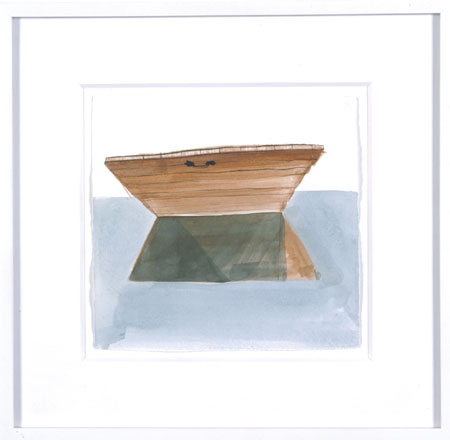
Kara Walker, “Untitled,” 2004.
Water color on paper, 18 works,
each 29.5 x 30.5 cm (framed).
Courtesy of Sikkema Jenkins & Co., New York.
Act 1: Iceland, March 24 – April 16, 2006
WORKSHOP
Revisiting Nordic Colonialism:
Local Amnesia – Global Impact
The Reykjavik Academy, Reykjavik
March 25 – 28, 2006, all days 12 – 5 pm
This four-day workshop will place the Nordic region in a global context and look into its colonial past and the fact that this past is widely repressed. It aspires to determine what questions are important and necessary for a progressive, postcolonial debate in the region.
PARTICIPANTS
Ívar Jónsson (Iceland)
Mikela Lundahl (Sweden)
Steve Ouditt (Trinidad, The West Indies)
Humphrey Polepole (Tanzania)
Vandana Shiva (India)
MODERATORS: Jón Ólafsson (Iceland), Ólöf Gerður Sigfúsdóttir (Iceland)
& Ragnhildur Sigurðardóttir (Iceland)
Address/Admission:
JL-house, 4th floor, Hringbraut 121, 107 Reykjavik
t: +354 562 8561, e: reykjavikur@akademia.is, www.akademia.is
Admission free
Workshop Program (download program here):
Day 1: March 25
12 –12:45 pm: Introduction to the workshop by Kuratorisk Aktion (Curators of Rethinking Nordic Colonialism) and Jón Ólafsson (Chairman, Reykjavik Academy and Professor of Philosophy at the Bifröst School of Business).
12:45 – 2 pm: “Nordic Complicity? Some Aspects on Nordic Identity as ‘Non-Colonial’ and Non- Participatory in the European Colonial Event,” a presentation by Mikela Lundahl (Ph.D. in History of Ideas, Researcher at Gothenburg University and Associated Professor in Cultural Studies at University West, Sweden). The presentation is followed by a Questions & Answers session.
2 – 2:30 pm: Coffee & Snack Break.
2:30 – 3:45 pm: “Plantation Economy and Trademark Capital,” a presentation by Steve Ouditt (Visual artist and Lecturer at the University of the West Indies, St. Augustine, Trinidad). The presentation is followed by a Questions & Answers session.
3:45 – 4 pm: Coffee Break.
4 – 5 pm: Open Discussion and Closing Remarks.
Day 2: March 26
12 – 12:15 pm: Opening Remarks by Ólöf Gerður Sigfúsdóttir (Member of the Board of Directors, Reykjavik Academy).
12:15 – 1:30 pm: “From Colonialism to Organisational Dependency,” a presentation by Ívar Jónsson (Professor at the Department of Social Sciences and Economics, The Bifröst School of Business, Borgarfjörður, Iceland). The presentation is followed by a Questions & Answers session.
1:30 – 2 pm: Coffee & Snack Break.
2 – 3:15 pm: “Third World Underdevelopment, Economic Crisis, Foreign Aid and Aids Policies as a Legacy of Colonialism: Challenges and Opportunities,” a presentation by Humphrey Polepole (Secretariat Director of the Tanzania Youth Coalition (TYC) and Steering Committee Member of the Sustainability Watch Network). The presentation is followed by a Questions & Answers session.
3:15 – 3:30 pm: Coffee Break.
3:30 – 5 pm: Open Discussion and Closing Remarks.
Day 3: March 27
12 – 12:15 pm: Opening Remarks by Ragnhildur Sigurðardóttir (Ecologist and Lecturer at the University of Iceland and University of Washington).
12:15 – 1:30 pm: Vandana Shiva (Scientist and Environmental Activist. Director of The Research Foundation for Science, Technology and Ecology (RFSTE) and Navdanya, a movement for biodiversity conservation and farmers' rights, New Delhi, India). Title to be announced. The presentation is followed by a Questions & Answers session.
1:30 – 2 pm: Coffee & Snack Break.
2 – 3 pm: Open Discussion.
3 – 3:15 pm: Coffee Break.
3:15 – 4 pm: Open Discussion and Closing Remarks.
Day 4: March 28
12 – 12:15 pm: Opening Remarks by Ólöf Gerður Sigfúsdóttir (Member of the Board of Directors, Reykjavik Academy).
12:15 – 1:30 pm: Discussion of Concluding Statement by Workshop Participants.
1:30 – 2 pm: Coffee & Snack Break.
2 – 3 pm: Production of Concluding Statement by Workshop Participants.
3 – 3:15 pm: Coffee Break.
3:15 – 4:15 pm: Presentation of Concluding Statement and Closing Remarks.
ÍVAR JÓNSSON
Lives and works in Reykjavik, Iceland.
Ívar Jónsson is Professor at the Bifröst School of Business in Iceland. He is a former Docent/Senior Lecturer at the Luleå University of Technology in Sweden and former Lecturer and Pro-Rector at the University of Greenland. He has written books and articles on West-Nordic Countries, independence struggle, institutionalized racism, and socio-economic development. In addition, his research focuses on innovation and the cooperative movement. Jónsson received his D.Phil. in Social Implication of Technical Change from the Department of Political Thought at the University of Sussex in 1992. He has a MA degree in History and Philosophy of Social and Political Science from the University of Essex and a BA in Social Sciences from the University of Iceland.
Jónsson participates with the paper “From Colonialism to Organisational Dependency.” In his outline of the paper, he writes: “Many former colonies have become independent since the 1950s. Since the 1970s many nations within former colonies and colonial countries have struggled for sovereignty and received autonomy. Home rule has been organised in autonomous areas, but this form of government does not necessarily lead to successful development towards increasing independence. The problem of organisational dependency explains partly why autonomous people may remain economically, culturally and politically dependent on their former colonial powers. In this presentation, the problem of organisational dependency will be discussed. The cases of the West-Nordic Countries will be observed in order to illustrate different paths and forms of organisational dependency. Finally, the impact of globalisation and growth of transnational classes on the post-colonial situation will be discussed.” [Ívar Jónsson]
MIKELA LUNDAHL
Born 1965 in Gothenburg, Sweden. Lives and works in Gothenburg.
Mikela Lundahl is a Ph.D. in History of Ideas. Her thesis Vad är en neger? Negritude, essentialism, strategi (What is a Negro? Negritude, Essentialism, Strategy) from 2005 is a study of the negritude movement and the main figures in it, Léopold Sédar Senghor and Aimé Césaire. The main objective of the study is, through a close reading of their writings, to understand the paradox of an anti-racist work that is said to be essentialist. The result is that maybe the white anti-racist readers were too occupied with the construction of themselves as anti-racist so that they were not able to see and understand the historical circumstances and the possible and necessary strategies that were required. The study, as well as other works, is a part of Lundahl’s interest in identity politics – the impossibilities and the necessities for them. She uses feminist theory, queer theory, and of course postcolonial theory in her analysis of different contemporary problems. A special interest has been the representation of Africa and African history in Sweden and Europe. She is also engaged in a project at Gothenburg University, Sweden, where she tries to work out new models of teaching that contest and challenge the canon. She is a member of the board of the review Glänta that is going to cooperate with the next Documenta exhibition. She is an Associated Professor in Cultural Studies at the University West in Sweden.
Lundahl participates with the paper “Nordic Complicity? Some Aspects on Nordic Identity as ‘Non-Colonial’ and Non-Participatory in the European Colonial Event.” In her abstract of the paper, she writes: “I want to discuss and present the current representation of the East Indiaman ship “Götheborg,” which is a new replica of an old sailing ship from the 18th century that recently left the harbor of Gothenburg to ‘redo’ the historical trip between Scandinavia and China. The interesting thing about this event is that the colonial era or the colonial circumstances are never even mentioned – except when a couple of ambassadors proudly write that this event celebrates Sweden’s non-colonial history! In the foreword to the new official book on the project, the chairman explains:
“The East Indiaman ‘Götheborg’ unites a wide range of different fields: history, craftsmanship, marine engineering, culture, politics, marketing, and trade and industry. But above all it links people in different parts of the world. The East Indiaman ‘Götheborg’ is and will remain an important link and a symbol for good relations and trade between Sweden and China, and all the other countries the ship will visit during her voyage.” (The Swedish ship Götheborg sails again, 2005)
This event is used to confirm the conception of today’s Sweden as equal, and that this equality has a long tradition back in history. The Haitian historian Michel-Rolph Trouillot uses the phrase ‘silencing the past’ in his book with that very title to show how unthinkable or inconvenient events are written out of history. In this case, we are not talking about things that are unknown but systematically forgotten or considered not worthy or not important in this very context. Who decides that? What would all those people, who died only to serve this trade, think about this ‘symbol of good relations;’ all the slaves, who worked in Latin American silver mines to supply the necessary currency; all the slaves, who were a part of this chain of commodities that were exchanged – would they agree that ‘the whole story’ is told when theirs is not mentioned?” [Mikela Lundahl]
STEVE OUDITT
Born 1960 on Trinidad, The West Indies. Lives and works in St. Augustine, Trinidad.
Steve Ouditt is an artist and lecturer at the University of the West Indies, St. Augustine, Trinidad. He has worked as a Curator of Education and Research at the Institute of International Visual Arts [inIVA], London, and as a Lecturer at The Caribbean School of Architecture, Kingston, Jamaica. He has also been a researcher at the Jan van Eyck Academy, Maastricht, The Netherlands, and a visiting lecturer at the School of Architecture at Universidad Nacional Pedro Henrique Urena [UNPHU] in Santo Domingo, The Dominican Republic. His book creole in-site was published in London in 1998 by inIVA. Steve is presently researching how political communication engages design culture to create meanings of the nation, citizenship, law, culture, and human rights.
Steve Ouditt participates with the paper “Plantation Economy and Trademark Capital.” In his outline of the paper, he writes: “This presentation will use contemporary custom-designed pictograms to reflect and speculate on social, cultural, political, and business exchanges and the colonial imagination from the past, through the present and to the future. The aim is to propose a long-term education project – in the everyday world of social and cultural interaction and trade – in rethinking Nordic Colonialism by enlisting the support of citizens of all strata to display, reproduce, and distribute copies of the pictograms. In this way, a community of re-thinkers across professions and disciplines will be able to identify and support each other, in learning and teaching more about critical issues in colonialism, thus enlarging the community of critical thinkers in space and over time. These pictograms can function like a storyboard, identifying key scenes and sites in the continuum.” [Steve Ouditt]
HUMPHREY POLEPOLE
Lives and works in Dar es Salaam, Tanzania.
Humphrey Polepole is the current Secretariat Director of the Tanzania Youth Coalition (TYC), the biggest youth movement in Tanzania. He is also the Steering Committee Member of the Sustainability Watch Network under Tanzania Coalition on Sustainable Development (TCSD). He has recently been elected to join the Steering Committee of the Social Watch preparation at the East African sub-region and is a member of Policy Advisory Board of MS Tanzania. Polepole has held several positions at local, national, and international levels in the civil society and in the United Nations as a United Nations Environment Programme Associate Youth Advisor for Africa. Several times, he has been part of the United Republic of Tanzania (URT) government delegation, attending high-level meetings at the United Nations Framework Convention on Climate Change (UNFCCC). He has also served the World Youth Organization on Climate Change as a Southern region youth representative. Polepole has also taken an active role in the Rio+10 NGO process in the South and is a Chair of the East African Youth Coalition (EAYC) on Sustainable Development. He has taken a lead role in several reviews of policies, including the National Strategy for Growth and Reduction of Poverty (NSGRP) and the post review and evaluation process for the Johannesburg Summit, focusing on the Tanzania Rio+10 partners and the East African Rio+10 NGO Coalition participation. He was selected to join a six people taskforce to anticipate the future of the sustainable development NGO process in East Africa, being the youngest member of the team. He has worked on policy issues as an analyst at local, national, and international levels. Furthermore, he is a trainer on research methodologies and has conducted trainings on Participatory Rural Appraisal (PRA), Appreciative Inquiry (AI), and Participatory Learning and Action for Community Development (PLA-CD).
Humphrey Polepole will deliver the paper “Third World Underdevelopment, Economic Crisis, Foreign Aid and AIDS Policies as a Legacy of Colonialism: Challenges and Opportunities.” In his outline of the paper, he writes: “The social, economic, and political problems in the Third World countries are said to have been developed, or fueled, by the developed nations. This has led to a number of scholars researching the possible causes of the economic and political crisis in the Third World countries. Some have argued that Third World underdevelopment, economic crisis, foreign aid, and AIDS policies are all legacies of colonialism. Nowhere in Africa were positive contributions made by colonialism to any substantial extent. Countries like Nigeria and Ghana, which were among the better endowed colonies, were left with only a few rail lines, rudimentary infrastructure, and a few thousand graduates. Other countries were left with far less. Historians have argued that the main goal of colonialism was the search for raw materials, cheap labor, and markets for their produce and that religion was the brainwashing method employed to penetrate the strong bonds of the African societies! Also, the devastating impact of slave trade resulted in Africa loosing almost fifteen million workers, who would have driven the continent to a very promising future. Lastly, when the colonizers handed over the administration of the colonies to the colonies themselves, the independent national governments were never meant to prosper but remain dependent. The former colonies were left with poor infrastructures as well as social, economic, and political dilemmas. When the map of Africa was redrawn, diverse peoples were thrown together and ethnic conflicts arose, which continue to destabilize the continent. We still have so many challenges ahead of us, but also opportunities. If addressed properly, Third World countries can still make a U-turn to prosperity!” [Humphrey Polepole]
VANDANA SHIVA
Born 1952 in Dehra Dun, India. Lives and works in New Delhi, India.
Dr. Vandana Shiva is trained as a Physicist and received her Ph.D. from the University of Western Ontario in Canada. She later shifted to interdisciplinary research in science, technology, and environmental policy, which she carried out at the Indian Institute of Science and the Indian Institute of Management in Bangalore, India. In 1982, she founded an independent institute, The Research Foundation for Science, Technology and Ecology, in Dehra Dun, dedicated to high quality and independent research to address the most significant ecological and social issues of our times, in close partnership with local communities and social movements. In 1991, she founded Navdanya, a national movement to protect the diversity and integrity of living resources, especially native seed, the promotion of organic farming, and fair trade. In 2004, she started Bija Vidyapeeth, an international college for sustainable living in Doon Valley in collaboration with Schumacher College, United Kingdom. Dr. Shiva’s books The Violence of Green Revolution and Monocultures of the Mind have become basic challenges to the dominant paradigm of non-sustainable, reductionist Green Revolution Agriculture. Through her books Biopiracy, Stolen Harvest, and Water Wars, Dr. Shiva has made visible the social, economic, and ecological costs of corporate led globalization. In addition, Dr. Shiva’s contributions to gender issues are nationally and internationally recognized. Her book Staying Alive dramatically shifted the perception of Third World women. In 1990, she wrote a report for the FAO on women and agriculture entitled “Most Farmers in India are Women.” She founded the gender unit at the International Centre for Mountain Development (ICIMOD) in Kathmandu and was a founding Board Member of the Women Environment and Development Organisation (WEDO). She has initiated an international movement of women working of food, agriculture, patents, and biotechnology called Diverse Women for Diversity. Dr. Shiva is the recipient of a number of international awards and has lectured across the US, Canada, and Europe. She chairs the Commission on the Future of Food, is a Board Member of the International Forum on Globalization, and a member of the Steering Committee of the Indian People’s Campaign against WTO. [Research Foundation for Science, Technology and Ecology]
Vandana Shiva was supposed to have delivered a paper during the third day of Act 1's workshop. However, she was unable to attend and will turn in a paper instead, which will be available on www.rethinking-nordic-colonialism.org after December 1, 2006.
